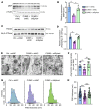The Eph receptor A4 plays a role in demyelination and depression-related behavior
- PMID: 35271507
- PMCID: PMC9012277
- DOI: 10.1172/JCI152187
The Eph receptor A4 plays a role in demyelination and depression-related behavior
Erratum in
-
The Eph receptor A4 plays a role in demyelination and depression-related behavior.J Clin Invest. 2022 May 16;132(10):e161559. doi: 10.1172/JCI161559. J Clin Invest. 2022. PMID: 35575094 Free PMC article. No abstract available.
Abstract
Proper myelination of axons is crucial for normal sensory, motor, and cognitive function. Abnormal myelination is seen in brain disorders such as major depressive disorder (MDD), but the molecular mechanisms connecting demyelination with the pathobiology remain largely unknown. We observed demyelination and synaptic deficits in mice exposed to either chronic, unpredictable mild stress (CUMS) or LPS, 2 paradigms for inducing depression-like states. Pharmacological restoration of myelination normalized both synaptic deficits and depression-related behaviors. Furthermore, we found increased ephrin A4 receptor (EphA4) expression in the excitatory neurons of mice subjected to CUMS, and shRNA knockdown of EphA4 prevented demyelination and depression-like behaviors. These animal data are consistent with the decrease in myelin basic protein and the increase in EphA4 levels we observed in postmortem brain samples from patients with MDD. Our results provide insights into the etiology of depressive symptoms in some patients and suggest that inhibition of EphA4 or the promotion of myelination could be a promising strategy for treating depression.
Keywords: Cell Biology; Demyelinating disorders; Molecular biology; Neuroscience.
Conflict of interest statement
Figures









Similar articles
-
Increased EphA4-ephexin1 signaling in the medial prefrontal cortex plays a role in depression-like phenotype.Sci Rep. 2017 Aug 2;7(1):7133. doi: 10.1038/s41598-017-07325-2. Sci Rep. 2017. PMID: 28769056 Free PMC article.
-
The enriched environment ameliorates chronic unpredictable mild stress-induced depressive-like behaviors and cognitive impairment by activating the SIRT1/miR-134 signaling pathway in hippocampus.J Affect Disord. 2019 Apr 1;248:81-90. doi: 10.1016/j.jad.2019.01.031. Epub 2019 Jan 28. J Affect Disord. 2019. PMID: 30716615
-
Role of proBDNF and BDNF in dendritic spine plasticity and depressive-like behaviors induced by an animal model of depression.Brain Res. 2017 May 15;1663:29-37. doi: 10.1016/j.brainres.2017.02.020. Epub 2017 Mar 8. Brain Res. 2017. PMID: 28284898
-
Chronic unpredictable mild stress-induced behavioral changes are coupled with dopaminergic hyperfunction and serotonergic hypofunction in mouse models of depression.Behav Brain Res. 2019 Oct 17;372:112053. doi: 10.1016/j.bbr.2019.112053. Epub 2019 Jul 6. Behav Brain Res. 2019. PMID: 31288060
-
Amyloid-β oligomers synaptotoxicity: The emerging role of EphA4/c-Abl signaling in Alzheimer's disease.Biochim Biophys Acta Mol Basis Dis. 2018 Apr;1864(4 Pt A):1148-1159. doi: 10.1016/j.bbadis.2018.01.023. Epub 2018 Jan 31. Biochim Biophys Acta Mol Basis Dis. 2018. PMID: 29378302 Review.
Cited by
-
A Disintegrin and Metalloproteinase 10 (ADAM10) Is Essential for Oligodendrocyte Precursor Development and Myelination in the Mouse Brain.Mol Neurobiol. 2023 Mar;60(3):1675-1689. doi: 10.1007/s12035-022-03163-0. Epub 2022 Dec 23. Mol Neurobiol. 2023. PMID: 36550333 Free PMC article.
-
Systemic Inflammation Leads to Changes in the Intracellular Localization of KLK6 in Oligodendrocytes in Spinal Cord White Matter.Neurochem Res. 2023 Sep;48(9):2645-2659. doi: 10.1007/s11064-023-03929-5. Epub 2023 Apr 17. Neurochem Res. 2023. PMID: 37067738
-
Dysregulation of myelination-related genes in schizophrenia.J Neurochem. 2024 Sep;168(9):2227-2242. doi: 10.1111/jnc.16152. Epub 2024 Jul 31. J Neurochem. 2024. PMID: 39086020 Free PMC article. Review.
-
Transcriptome analysis of rats with chronic unpredictable mild stress treated with electroacupuncture.Brain Behav. 2024 Sep;14(9):e70045. doi: 10.1002/brb3.70045. Brain Behav. 2024. PMID: 39295096 Free PMC article.
-
Stress-Induced Cholesterol Metabolic Dysregulation and Differentiation Trajectory Shift in Oligodendrocytes Synergistically Drive Demyelination.Int J Mol Sci. 2025 Apr 9;26(8):3517. doi: 10.3390/ijms26083517. Int J Mol Sci. 2025. PMID: 40332029 Free PMC article.
References
Publication types
MeSH terms
Substances
LinkOut - more resources
Full Text Sources
Miscellaneous

